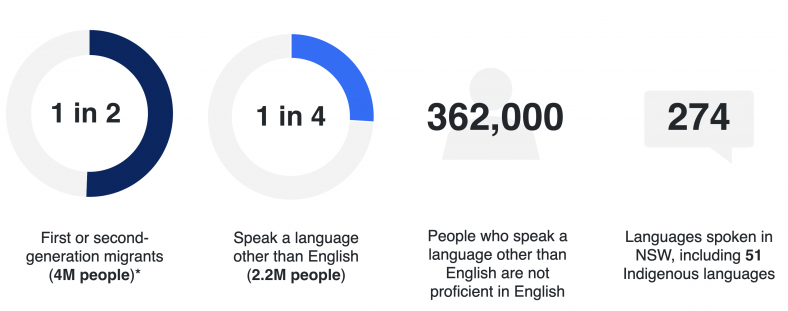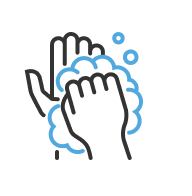Improving accessibility for culturally and linguistically diverse (CALD) audiences
1 in 4 NSW residents speak a language other than English at home. This is how we cater for Culturally and Linguistically Diverse (CALD) audiences on nsw.gov.au.
Improving accessibility for culturally and linguistically diverse (CALD) audiences
Did you know that 1 in 4 NSW residents speak a language other than English at home? That's approximately 2.15 million people.
NSW is Australia’s most culturally & linguistically diverse state/territory

Making nsw.gov.au more accessible and easier to navigate is a major goal of the OneCX Program. The OneCX Program is creating a better digital experience for the people of NSW, by bringing together individual NSW Government websites to nsw.gov.au. In doing so, we’re making government information easy to understand – for all audiences.
How the OneCX Program is catering to CALD audiences
Social isolation, low digital literacy and limited English skills can lead to exclusion. Those most at risk of missing out on important government information are the elderly, disabled and recently arrived migrants.
According to Census data from the Australian Bureau of Statistics:
• NSW households speak 274 languages (including 51 Indigenous languages)
• half of these households speak Mandarin, Cantonese, Arabic or Vietnamese
• 18% of NSW residents reported having limited English skills.
Which CALD communities are at risk of exclusion?
Languages by low English language proficiency population
Language groups with the largest population growth since 2016
Graphs exclude English.
The ABS Census captures English proficiency as a self-rated measurement of one’s ability in spoken English.
The OneCX Program is transforming the digital experience of NSW Government for citizens. Our commitment is to create content that is easy for everyone to understand.
We deliver an accessible user experience on nsw.gov.au by:
• making translated resources more discoverable across the site.
• offering machine translation on all pages

• using human translation for our most-visited pages and critical information, such as COVID content
• including graphics and videos to aid comprehension

• creating Easy Read resources to simplify information
• providing a text-to-audio playback option

In addition, we have recently been testing a hybrid solution that blends machine and human translation on key COVID and floods content, with promising results.
How are CALD communities currently using nsw.gov.au?
Meeting the needs of CALD communities
Different cultures have different expectations and preferences when it comes to communication. We conduct regular research with CALD users to ensure that it meets their needs.
This includes testing with users who have limited English skills.
We also run focus groups with those who are more fluent. They play an important role in educating family, friends and the broader community.
We partner with CALD news outlets and community leaders to distribute vital information. Our social team creates assets in many languages, targeting specific user groups.
Our team has developed an accessibility guidance tool to help staff create content. The guide provides recommendations about the best format and channel for specific audiences. Research indicates the priority languages are Arabic, Chinese, Vietnamese and Korean.
Sharing insights and research between agencies and organisations is crucial. We frequently engage with partners and stakeholders, including:
• Department of Customer Service CALD Community of Practice
• Multicultural NSW
• Multicultural Health Communications Service
This work goes a long way towards improving accessibility for CALD users. Ensuring that everyone in the community can access government services and program information, regardless of ability, location or experience, is a priority for nsw.gov.au.
Leave a comment below if there are accessibility enhancements you’d like to see on nsw.gov.au.
Stay up-to-date
Keep in the know of OneCX Program milestones, launches and upcoming work. Subscribe to the monthly newsletter.
Statistical Source: ABS Census TableBuilder 2021, filtered for NSW.